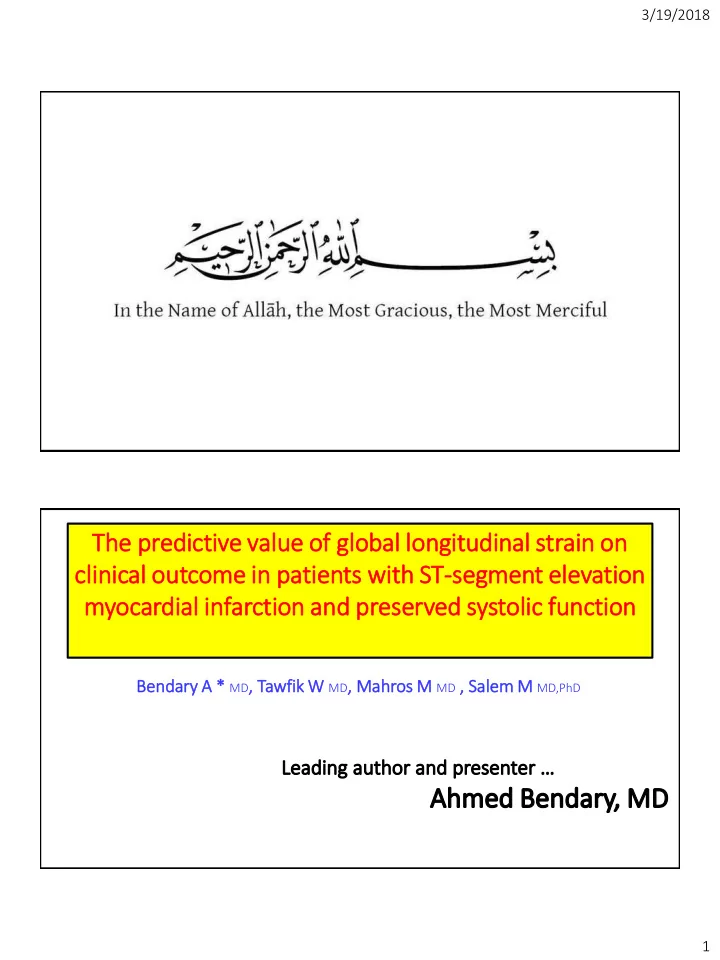

3/19/2018 The e predictive valu lue of of glo global lon longitudinal str train on on clin clinical ou outcome in in pati tients wit ith ST-segment ele elevation myocardial in infarction and preserv rved systolic fu function Ben endary A A * * MD , T , Tawfi fik W MD , , Mah ahros M M MD , , Sale Salem M MD,PhD 1
3/19/2018 • Not all patients with preserved LVEF after STEMI are equal when it it comes to to short an and long long term erm out outcome. • Measurement of of LVEF fol ollowing STEMI has long been a cornerstone step for risk stratification process that helps to to guide treatment decisions and other secondary preventive mea easures. • Patients with preserved LVEF following STEMI are always left with weak and ambiguous treatment rec amb ecommendatio ions in in the he gui guidelines. • HO HOWEVER, LVE VEF lac lacks ris isk disc discriminative po power wit ithin no normal ran anges. 2
3/19/2018 • The main focus in in recent few years has been on on global longitudinal strain (GLS) which reflects the function of of sub-endocardial longitudinal myofibers that are very sen sensi sitive to to isch ischemic ic da damage. • We We think that it’s essential to to look for novel measures for LV LV systolic function (other than LVEF) which could define high risk patients among a group that has alw always be been mis istakenly tho hought to to be be at at lo low risk isk. • Th Thus, we we thought that it it may be be of of considerable interest to to explore the predictive value of of early GLS on on 30 30-day outcome among apparently low-risk patients with suc success ssful rep eperfusio ion and and pr preserved LVE VEF follo ollowing STEMI. 3
3/19/2018 4
3/19/2018 5
3/19/2018 LVEF < 50% VEF < 50% 165 165 with suc uccess essful re reper erfusi sion on scr cree eened ed 16 16 ex excluded • AF (n= n=8) 8) • Pace e rhyt ythm (n= n=3) 3) • Mor ore tha han mild AS (n= n=5) 5) 149 149 rem remaining 9 ex excl cluded ed due due to po poor or image e qua quality 140 rem 140 remaining 30 ex 30 excluded due due to LVEF < 50% 110 110 pa patien ents s lef eft for r fina nal ana nalysi sis 6
3/19/2018 DM= Diabetes Mellitus, HTN= Hypertension, FH= Family history, CAD= Coronary artery disease, PH= Past history, STEMI= St- elevation myocardial infarction, PCI= Percutaneous coronary interventions, CABG= Coronary artery bypass graft 7
3/19/2018 ESV= End-systolic volume, EDV= End-diastolic volume, EF= Ejection fraction, GLS= Global longitudinal strain, WMSI= Wall motion score index 8
3/19/2018 Cut ut-off Sen Sensiti tivity 77. 77.8% Spe Specific icity ty 83. 83.7% 9
3/19/2018 • Cas ase # 17 17 • Male ale, 55 55 years old old • An Anterior STEMI rec eceived PPCI • Bas aseli line LVE VEF by by Sim Simpson is is 56 56% • Bas aseli line GLS LS – 13 13.8% • No No rep eported MACEs at at 30 30-days Fu Fup A. Apical-4 chamber (AP4) longitudinal strain B. Apical-2 chamber (AP2) longitudinal strain C. Apical-3 chamber longitudinal strain D. Bull’s eye polar map of GLS. 10
3/19/2018 • Semiautomated calculation of of GLS si significantly predicts 30-day 30 adverse outcome in in patients with preserved LVEF fol ollo lowing STEMI above and beyond traditional ide identif ifiers of of hig high risk isk. • We We recommend close monitoring to to those patients by by scheduling frequent fol ollow-up up visi sits and attention to to proper prescription of of guideline directed medical and in interventio ional the herapie ies. 11
Recommend
More recommend